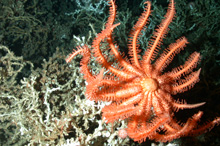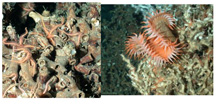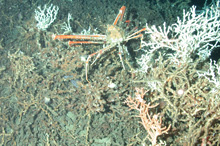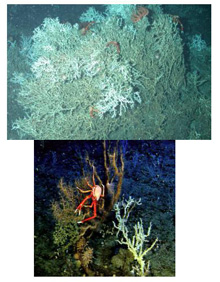
Figure 1. The brisingid sea-star (Novodinia antillensis) is an obvious large invertebrate that perches high in the coral branches (Lophelia pertusa here) to filter feed. This photo from off North Carolina in about 370 m is far north of the normally known range of this species. Click image for larger view and image credit.
Figure 2. The majid crab (Rochina crassa) among the Lophelia corals. This is a large crab that roams over both coral and non-coral habitat. Although difficult to see there are also sea urchins, anemones and small brittle stars within the coral branches. Click image for larger view and image credit.
A Reef is a Reef, is a Reef - or is It? Biodiversity and Habitats of Invertebrates Associated with Deep-Sea Corals of the Southeastern United States
Martha Nizinski, PhD
Zoologist
NOAA, National Marine Fisheries Service
National Systematics Laboratory
![]() Cruising along a deep coral ridge off North Carolina, showing dense, live (white) Lophelia corals. (Quicktime, 346 Kb.)
Cruising along a deep coral ridge off North Carolina, showing dense, live (white) Lophelia corals. (Quicktime, 346 Kb.)
Shallow-water tropical coral reefs are often referred to as ‘hotspots of biodiversity.’ These ecosystems support a vast array of organisms, often in high densities, and appear as oases in an otherwise seemingly depauperate (species poor) habitat. Coral reefs also occur in deep-sea environments and are the subject of our project (see World of Deep Sea Corals essay). Do these deep-water reefs function in the same way as shallow reefs? Do they support a greater abundance of animals and highly diverse faunal assemblages compared to surrounding non-reef habitats? The fauna associated with deep-water coral reefs is poorly known compared to that of tropical coral reefs. Although evidence suggests that diversity is as high at some deep-water reefs in the Atlantic as occurs on their shallow-water counterparts, we are still in the early stages of faunal discovery for our western Atlantic study sites. Even so, one of the things that first caught our attention about the deep sea coral ecosystems was the great array of invertebrate animals. Sampling on, around, and between deep-sea coral reefs from North Carolina to east-central Florida will help us gain a better understanding of the diversity of the invertebrate fauna associated with these habitats. It will also allow us to examine in detail the habitat associations between invertebrates and the reefs they call home. Integrating this with the other components of our study, especially the fish surveys and genetics, will give us greater insight into how the whole system functions.
Many organisms found in shallow-water coral reef environments utilize the structure these reef habitats provide. Structure is an important variable determining local distributions of marine invertebrates in both shallow and deep-sea environments. The deep-reef associated fauna use structure in a variety of ways, including as a substratum for attachment, as a place to find food, as a structure to facilitate food capture, to gain protection from predators, or to find a mate. Both physically attached animals, such as the sea anemones, as well as other organisms including brisingid sea stars and galatheid crabs (squat lobsters), which perch atop the coral branches, take advantage of fast moving currents that deliver a variety of prey organisms over the reefs. Deep-water coral reefs are often found in areas of high currents, and the reefs themselves change the flow of the water, increasing current speeds for water passing over the reefs. This is beneficial for the coral polyps, anemones, and brisingid sea stars that feed on the plankton in the water column and to other organisms, like the galatheid crabs, which wait with their claws open and raised above the reef plane to capture larger animals, including small fishes, passing by in the water column.

Figure 4. Left: Close up view of small brittle stars (Ophiacantha bidentata) that are very abundant within the corals at some sites. Right: Venus flytrap anemone is a common filter feeding invertebrate that attaches to the corals. Note also small, pinkish brittle stars within the corals around the anemone. Click image for larger view and image credit.
Recent work with shallow-water reefs suggests that organisms may have very specific requirements with regard to the microhabitat they inhabit. We will be exploring habitat associations of invertebrate fauna occurring on deep reefs. Though deep-sea organisms are often considered to be opportunistic, i.e., utilizing a variety of habitats, it is still unclear whether the assemblage of invertebrates we find on the reefs off the southeastern United States have relationships with the corals that are obligate (i.e., found only at these reef habitats) or facultative (i.e., representative of the regional fauna and use reef resources opportunistically). As we gather more data, we discover evidence for both kinds of relationships. For example, some gastropods and echinoderms are found almost exclusively on Lophelia coral, whereas species-specific associations between galatheid crabs and various coral species are not apparent (![]() See a video of Lophelia coral). Galatheid crabs appear to utilize any coral species to facilitate their attempts to be on hard substrata elevated above the bottom. Additionally, not all invertebrate species prefer live coral habitat. Majid crabs and brittle stars are more often found in the rubble zone near the live coral habitat than on the living corals themselves. With further investigation, we also expect to find a different grouping of invertebrates that is more associated with the unstructured, soft sediment environments located away from the coral reef.
See a video of Lophelia coral). Galatheid crabs appear to utilize any coral species to facilitate their attempts to be on hard substrata elevated above the bottom. Additionally, not all invertebrate species prefer live coral habitat. Majid crabs and brittle stars are more often found in the rubble zone near the live coral habitat than on the living corals themselves. With further investigation, we also expect to find a different grouping of invertebrates that is more associated with the unstructured, soft sediment environments located away from the coral reef.
As we continue our explorations, we will gather more data to examine the above questions. But, we are also acutely aware of the fact that working in any deep-sea environment always has the potential to reveal new, interesting, exciting, and sometimes completely unexpected findings.



























